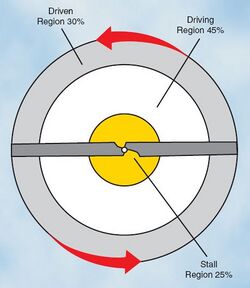Engineering:Unequal rotor lift distribution
Unequal rotor lift distribution[citation needed] is an effect where the blades of a helicopter rotor generate more lift at the rotor tips than at the rotor hub.[1]:1:11
A helicopter rotor blade is an airfoil, which is driven through the air to create lift. The lift generated is proportional to the square of the speed. Because the tips of the rotating blades travel much faster through the air than the parts of the blades near the hub, they generate much more lift.
If not mitigated, this effect would cause large bending stresses in the blade. In addition, the tip would have to be made stronger to handle the increased load.[2] Helicopter manufacturers use the following techniques to equalise lift across the blade:
- Washout is a geometric twist in the blade, such that the blade root near the hub has a higher angle-of-attack, thus higher lift.[3]:2-9[4]:1-20
- Varying the airfoil cross-section, such as flattening the airfoil towards the tip, or tapering the blade towards the tip, which reduces its surface area thus reducing lift.
These techniques also equalise drag[2] and downwash[5] along the blade.
The high twisting necessary for good hover performance unfortunately causes vibrations at high forward speeds, because the angle of attack of the blade tips may become negative,[6] so a compromise is typically made.[5][7] Tiltrotor aircraft such as the Bell Boeing V-22 Osprey are able to use more blade twist.[6]
There is also a limit to how tapered the blade tips can be, because the tips need sufficient mass to reduce vibrations and increase inertia after an engine failure.[7] In practice, most helicopters use blade twist but not taper,[7] because efficiency gains from taper are small but construction is more difficult.[8][6]
It is not possible to equalise rotor lift distribution at all rotor speeds, because lift increases quadratically with airspeed. Coning will still occur at higher RPMs.
See also
References
- ↑ AP3456 Manual of Flying, Vol 12 Helicopters. Central Flying School. https://assets.publishing.service.gov.uk/government/uploads/system/uploads/attachment_data/file/857310/Volume_12_Helicopters.pdf.
- ↑ Jump up to: 2.0 2.1 Croucher, Phil (2007). Professional Helicopter Pilot Studies. p. 2-10. ISBN 9780978026905. https://books.google.com/books?id=AovdKRWSqJAC&dq=helicopter+washout&pg=SA3-PA3. Retrieved 18 January 2022.
- ↑ "2. Aerodynamics of Flight". Helicopter Flying Handbook. Federal Aviation Administration. 2012. https://www.faa.gov/regulations_policies/handbooks_manuals/aviation/helicopter_flying_handbook/media/hfh_ch02.pdf. Retrieved 17 January 2022.
- ↑ "1". Fundamentals of Flight FM 3-04.203. US Department of the Army. May 2007. https://irp.fas.org/doddir/army/fm3-04-203.pdf.
- ↑ Jump up to: 5.0 5.1 Croucher, Phil (2007). Private Helicopter Pilot Studies JAA BW. p. 2-13. ISBN 9780978026943. https://books.google.com/books?id=kfdaQCdNnYMC&dq=helicopter+washout&pg=SA2-PA13. Retrieved 18 January 2022.
- ↑ Jump up to: 6.0 6.1 6.2 Watkinson, John (2004). Art of the helicopter. Oxford: Elsevier Butterworth-Heinemann. p. 116. ISBN 9780080472034.
- ↑ Jump up to: 7.0 7.1 7.2 Prouty, Raymond W. (2009). Helicopter aerodynamics. Lebanon, Ohio: Eagle Eye Solutions. p. 22. ISBN 978-0557089918.
- ↑ Johnson, Wayne (1994). Helicopter theory. New York: Dover Publications. p. 67. ISBN 9780486131825. https://books.google.com/books?id=FiEapaNgjLcC&dq=helicopter+twist+washout+taper&pg=PA67. Retrieved 18 January 2022.
 |


